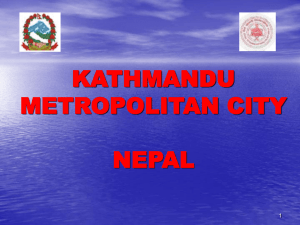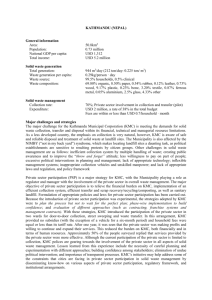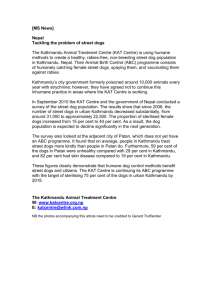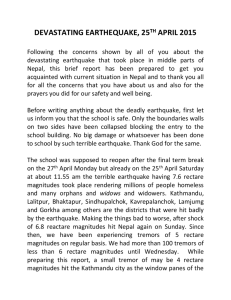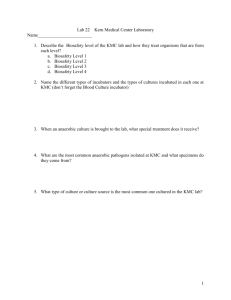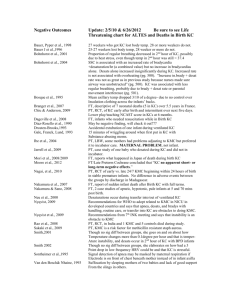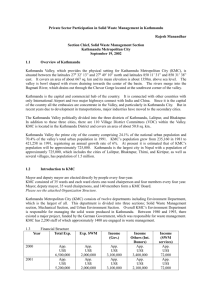Kathmandu Metropolitan City at a glance
advertisement
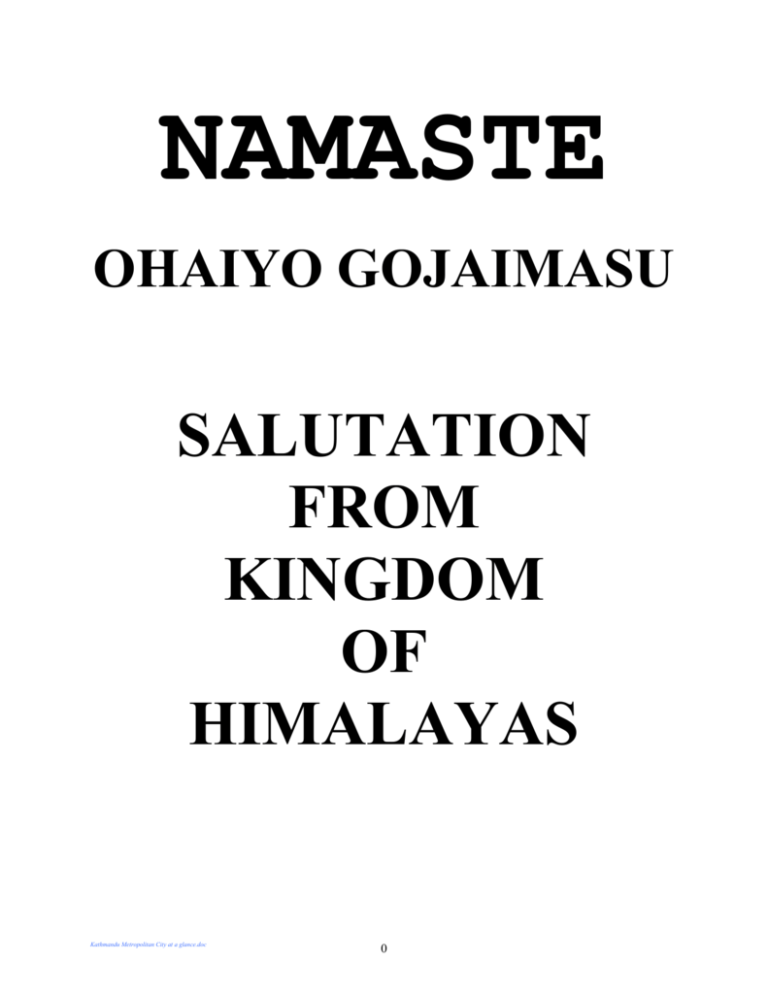
NAMASTE OHAIYO GOJAIMASU SALUTATION FROM KINGDOM OF HIMALAYAS Kathmandu Metropolitan City at a glance.doc 0 Kathmandu Metropolitan City at a glance Founded Location : 27° 42' North latitude : Tenth Century by Gunakama Dev 85° 20' East longitude Altitude : 1,350 meters (above sea level) Area : 51.3 Sq. Km. Climate : Sub-tropical cool temperate Maximum 35.6°C (April) Minimum –3°C (January) Annual rain fall : 1407 mm (most of it during June–August) Average humidity : 75 percent Population : 671, 846 (3 percent of national population – census 2001) Growth Rate : 4.64% Number of households: 1,52,155 (a.p.d. 175.7 per hector) Major religions Principal Languages : Nepali, Newari (English is understood and spoken by general public) World Heritage Sites : Durbar Square (Hanuman Dhoka), Swoyambhunath, Pashupatinath, Bouddha Nath Main economic activities : Trade, tourism, carpets, garments, cottage industries : Hinduism, Buddism Trade – 21% Manufacture – 19% Agriculture – 9% Education – 6% Transport – 6% Hotels & Restaurants – 5% Educational Institutions : 23 Colleges 98 Higher Secondary Schools 50 Lower Secondary Schools Kathmandu Metropolitan City at a glance.doc 1 236 Primary Schools 110 Pre-primary Schools Literacy rate : 83 Percent Health Services : 50 hospitals and Nursing homes 23 KMC run Urban Health Clinics Total length of roads : 1036 Km. (Blacktopped – 31%, Graveled – 16%, Earthen – 26%, Others – 27%) Airport : Tribhuvan International Airport (1,816,105 travelers pass through TIA annually) Existing Land use distribution : Residential (High density) Residential (Medium density) – 35% Residential (Low density) – 10% Commercial – 4% Institutional – 8% Industrial – 1% Open spaces – 6% Utilities – 1% Airport – 3% Road – 3% Water bodies – 1% Agriculture – 18% Others – 2% 100% – 8% Organizational Structure of Kathmandu Metropolitan City Office City Management/Current situation WATER WORK: The main sources – Rivers, rainfall and spring flow Drinking Water Current Demand : 140 million liters per day (m/d) (Wet Season – Surface Water 88.3%, ground 11.7%) Current Supply : 105.3 mld. (Dry Season – 70.8 mld – Surface 65%, ground 35%) Kathmandu Metropolitan City at a glance.doc 2 Total Storage Capacity : 27.65 – 70.8 mld Existing Pipeline : 491 Km. (Size 20mm diameter to 800mm) Leakage 40% SEWERAGE : : Combined storm water and sewer system (50–70 years old) Service : 17% of households Capacity : 40% 4 treatment plants : Capacity 17 million liters per day to treat Sewerage produced around 55,000 people on a year round basis. ELECTRICITY : 220 volt electricity supply 132 Kilovolt national grid served from 14 power generation stations, deliver 242 megawatt Supply, demand and consumption Approximately 100% of the population in KMC has access to the electricity supply system Maximum demand in KMC – 100 MW (approx) Bulk sub-station capacity – 161.3 MW Growing demand – 10% p.a. (average) Consumption – average 50% of the nation's annual electricity power consumed in KMC – 89% hydropower 11% diesel generated Telephone HOUSING : 80% service coverage in KMC – Domination of brokers in land development – Predominant private owner occupied housing system – 53,311 units Housing Stock/deficit 10,942 units in 1991/34000 additional housing units needed by 2003. – 2000 squatter families / 56 settlements – Standard Cost NRS.950,000.00 for 35 Sq.m. house in 80 Sq.m. plot Kathmandu Metropolitan City at a glance.doc 3 – Rate of Building Construction – 18.4% Building Typology of KMC RCC – 47% Fired Brick Cement Joint – 28% Mud Brick Plastered – 17% Mud Mortar Joint – 8% ROAD NETWORK – 705 Km. (approx) vehicle roads in Kathmandu District – 109,400 vehicles enter in 16 – hour period – 274 Km. of motorable roads within KMC Road Classification within Kathmandu District Classification Pitch Gravel Earth Total National Highways 21 0 0 21 Feeder Rods (Major) 17 0 0 17 Feeder Roads (Minor) 39 3 1 43 Districts Roads 332 67 32 431 Total 445 160 100 705 Kathmandu Metropolitan City at a glance.doc 4 Disaster Scenario of Kathmandu Metropolitan City 1. There are mainly 5 types of major disasters in Kathmandu Metropolitan City. They are: i. Earthquake ii. Fire iii. Flood iv. Epidemics v. Landslide (i) Earthquake First recorded Great EQ in 1256 AD (Abhaya Malla the Kind & his families died) The major E Q recorded 1259, 1407, 1680, 1681, 1767, 1809, 1823, 1833, 1834, 1916, 1926, 1934, 1988, 1993 A.D. Comparison of 1934 historical Great EQ and estimated scenario of mid Nepal EQ surveyed by JICA Team 1934 EQ (Actual) Mid Nepal EQ (estimated) 8.3 8.0 100 Km. East 150 Km. West Population 3,00,000 1,300,000 Seismic IntensityMMI VIII–IX VIII Building Damage 38,055 (60%) 128,952 (50%) Casualty (Deaths) 4296 (1.4%) 17,695 (1.3%) Magnitude Location (ii) Fire Incident in Kathmandu Valley per year. Incidents recorded Gas Kerosene Store 100 16% 11% Electrical Short Circuit 36% Candle burning Vehicles Unknown 7% 9% 21% (iii) Flood/Landslide/Lowland Incident in Kathmandu by the year 2002 Kathmandu Metropolitan City at a glance.doc 5 Families Population 550 7081 Affected Displaced House families destroyed 322 66 Injured Dead Missing 38 × 3 (Source: Nepal Red Cross Society) 2. Kathmandu Metropolitan City Office (KMC) is facing the following problems and constraints of management of disaster mitigation: (i) (ii) (iii) (iv) (v) (vi) (vii) Lack of resources and planning. Lack of coordination among GO/NGOs/INGOs working in the same field. Lack of modern technologies and methodologies Lack of mechanism to enforce building codes Lack of research works Lack of skilled manpower Lack of awareness among civil society and the leaders 3. KMC has taken following measures for Disaster Prevention & Mitigation: 1. 2. 3. 4. 5. 6. 7. Risk Assessment/vulnerability assessment Public awareness raising campaign Capacity building programmes Networking with GO/NGOs/INGOs Institutional Development Land use planning On the process of enforcement of building codes. 4. For the management of disaster on preparedness and mitigation KMC has undertaken following activities: 1. 2. 3. 4. 5. Vulnerability assessment in wards Observation of National Earthquake Safety Day Assessment of Emergency Services in KMC Community Based Disaster Management Training School Awareness Programme – DIG (Disaster Imagination Game), Seminar, Workshops, Art/Essay competitions. 6. Publication and distribution of educational and awareness raising materials 7. Public Hearing Programme with broad range participation of stakeholders Kathmandu Metropolitan City at a glance.doc 6 8. Information dissemination through KMC run radio Metro F.M. 106.7 Mhz. and Television Programmes in Nepal Television and highly circulated National Daily Newspapers. Disaster Management Through Citizens Participatory (A few Activities) 1. Vulnerability assessment in KMC Ward No. 5 and 20 Community Meetings Need assessments Formation of Committee Formation of survey team Identification of disaster prone areas Presentation to community Awared Community on disaster Preparedness activities by the community to the community 2. Community Based Disaster Management Training in KMC Ward No.: 34, 33, 14, 5, 4, 20 Community meetings Need Assessments Selection of participants Conduct DBDM Training Formation of trained volunteer Croups Public Awareness Campaign Preparedness activities 3. Disaster Imagination Game (DIG) in Ward No.: 20, 34 ( a highly popular technology transferred to KMC by JICA survey team) Community Meetings Need assessment Formation of groups Detail Exercise with the help of Ward Maps Identification of Disaster Prone Zone Kathmandu Metropolitan City at a glance.doc 7 Preparedness activities Kathmandu Metropolitan City at a glance.doc 8
